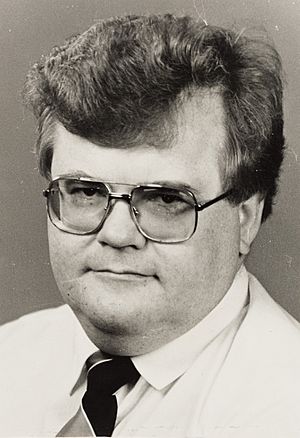Edgar Savisaar facts for kids
Quick facts for kids
Edgar Savisaar
|
|
|---|---|

Savisaar in 1992
|
|
| 1st Prime Minister of the Interim Government of Estonia | |
| In office 20 August 1991 – 29 January 1992 |
|
| President | Arnold Rüütel as Chairman of the Supreme Soviet (1990) as Chairman of the Supreme Council (1990–1992) |
| Preceded by | position established Otto Tief as last acting Prime Minister in 1944 |
| Succeeded by | Tiit Vähi |
| Minister of the Interior | |
| In office 12 April 1995 – 10 October 1995 |
|
| Preceded by | Kaido Kama |
| Succeeded by | Märt Rask |
| Mayor of Tallinn | |
| In office 9 April 2007 – 30 September 2015 |
|
| Preceded by | Jüri Ratas |
| Succeeded by | Taavi Aas |
| In office December 2001 – October 2004 |
|
| Preceded by | Tõnis Palts |
| Succeeded by | Tõnis Palts |
| Minister of Economic Affairs and Communications | |
| In office 12 April 2005 – 5 April 2007 |
|
| Prime Minister | Andrus Ansip |
| Preceded by | Andrus Ansip |
| Succeeded by | Juhan Parts |
| Personal details | |
| Born | 31 May 1950 Harku, Estonia |
| Died | 29 December 2022 (aged 72) Tallinn, Estonia |
| Political party | Communist Party (1983–1988) Popular Front (1988–1991) Centre Party (1991–2022) |
| Spouse | Vilja Laanaru (1996–2009) |
| Children | 4, including Erki Savisaar |
| Alma mater | University of Tartu |
Edgar Savisaar (born May 31, 1950 – died December 29, 2022) was an important Estonian politician. He helped start two big political groups: the Popular Front of Estonia and the Centre Party. He held many important jobs in Estonia. He was the first Prime Minister after Estonia became independent again. He also served as the Minister of the Interior, the Minister of Economic Affairs and Communications, and was the mayor of Tallinn twice.
Early Life and School
Edgar Savisaar was born in Harku, Estonia, in 1950. His parents were farmers.
After finishing high school, he went to the University of Tartu. In 1973, he earned a degree in history. Later, in 1980, he wrote a special paper about philosophy.
His Political Career
From 1980 to 1988, Savisaar worked in government jobs that planned the economy in Soviet Estonia. In 1988, he became a director at a company called "Mainor."
In April 1988, he helped create the Popular Front of Estonia. This was the first large political group in the Soviet Union that was not the Communist Party. At first, it supported changes in the Soviet Union, but it soon pushed for Estonia to become an independent country. This movement helped lead to the end of the Soviet Union.
In 1989, he became a Vice-Chairman of the Council of Ministers for Estonia. In 1990, he was the Minister of Economic Affairs. On April 3, 1990, he became the Chairman of the Council of Ministers. When Estonia declared its independence on August 20, 1991, he became the first Prime Minister of the Republic of Estonia.
His government worked until January 29, 1992. During this time, Estonia faced many economic problems. Prices went up very quickly (this is called hyperinflation), and there weren't enough goods in shops. People had to use special cards to buy food. In the winter of 1991-1992, there was a shortage of fuel. People had to wait in long lines for bread. Savisaar stepped down because it was very hard to manage the country's economy. Tiit Vähi took over as Prime Minister.
From 1992 to 1995, Savisaar was the Vice-Speaker of the Estonian Parliament, called the Riigikogu. From April to November 1995, he was the Minister for Internal Affairs. After some difficulties during his time as Minister, he decided to leave politics for a short time.
However, in 1996, he ran in local elections and became the chairman of the Tallinn City Council. From 2001 to 2004, he was the mayor of Tallinn, the capital city. In April 2005, he became the Minister of Economic Affairs and Communications again, working until March 2007. From 2007, he served as the mayor of Tallinn once more.
In 2006, Savisaar supported Arnold Rüütel for president, but Toomas Hendrik Ilves was elected. Savisaar did not agree with this outcome.
In 2016, there was a big discussion about choosing a new leader for the Centre Party. Savisaar decided not to run for the leadership position himself.
Edgar Savisaar wrote four books. He received important awards from Estonia, like the Order of the National Coat of Arms, and from Latvia, the Order of the Three Stars.
His Family Life
Edgar Savisaar was married three times and had four children. His son Erki Savisaar is also a politician in the Centre Party. He had a daughter named Maria and a son named Edgar from another marriage. His last marriage was to Vilja Toomast, who is also an Estonian politician. They had a daughter named Rosina. They separated in 2009.
Later Years and Death
In March 2015, Savisaar became very ill with an infection in his right leg. Doctors had to remove part of his leg to save his life. He got this infection while traveling in Thailand.
His health never fully recovered after this. In 2018, he was excused from a court case because he was too ill to attend.
Edgar Savisaar passed away on December 29, 2022, at the age of 72.
A special public funeral was held for him at the Estonia Theatre in Tallinn.
See also
 In Spanish: Edgar Savisaar para niños
In Spanish: Edgar Savisaar para niños

